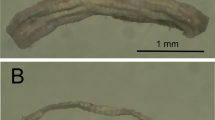Summary
Fibre-type classification of human skeletal muscle into type I and type II fibres is mostly based on their slight or strong staining with the myosin adenosine triphosphatase reaction. In order to evaluate the reliability of this screening technique a combined histochemical and biochemical study was performed on normal and diseased skeletal muscle of human subjects. In the present investigation activities of enzymes which play a role in the aerobic and anaerobic pathways and which can characterize fibre type, were examined in muscle specimens, with no apparent disease of the neuromuscular system. Special attention is given to the maximal activities of phosphofructokinase and fructose-1,6-diphosphatase, the rate limiting enzymes for the regulation of the glycolysis and glyconeogenesis, respectively. A most important feature of the biochemical findings is the constancy of the activity ratios of the examined enzymes. From these results and from the histochemical results it can be concluded that in apparently normal adult human skeletal muscle the ATP-ase technique for type I and type II typing is reliable. For fibres with an intermediate intensity of staining with the myosin ATPase technique of typing it is also necessary to apply other enzyme histochemical techniques.
Similar content being viewed by others
References
Bücher, T., Pette, D.: Über die Enzymaktivitätsmuster in Bezug mit Differenzierung der Skeletmuskulatur. Verh. dtsch. Ges. inn. Med. 71, 104–124 (1965)
Burstone, M.S.: Enzyme histochemistry. New York and London: Academic Press 1962
Dawson, A.P., Thorne, C.J.R.: The reaction of mitochondrial-L-3-glycero phosphate dehydrogenase with various electron acceptors. Biochem. J. 114, 35–40 (1969)
Fahimi, H.D., Amarasingham, C.R.: Cytochemical localization of lactic dehydrogenase in white skeletal muscle. J. Cell Biol. 22, 29–48 (1964)
Garcia-Buñuel, L., Garcia-Buñuel, V.M.: Connective tissue and the pentose phosphate pathway in normal and denervated muscle. Nature (Lond.) 213, 913–914 (1967)
Gumaa, K.A., McLean, P., Greenbaum, A.L.: Compartmentation in relation to metabolic control in liver. Essays Biochem. 7, 39–86 (1971)
Jöbsis, A.C., Meijer, A.E.F.H.: Evaluation of enzyme histochemical observations for metabolic studies. I. Histochemie 36, 51–61 (1973a)
Jöbsis, A.C., Meijer, A.E.F.H.: Evaluation of enzyme histochemical observations for metabolic studies. II. Histochemie 36, 63–71 (1973b)
Kendall, M.G.: Rank correlation methods. London: Griffin 1955
King Engel, W.: Fiber-type nomenclature of human skeletal muscle for histochemical purposes. Neurology (Minneap.) 24, 344–348 (1974)
Meijer, A.E.F.H.: Improved histochemical method for the demonstration of the activity of α-glucan phosphorylase. I. The use of glucosyl acceptor dextran. Histochemie 12, 244–252 (1968)
Meijer, A.E.F.H.: Histochemical method for the demonstration of myosin adenosine triphosphatase in muscle tissues. Histochemie 22, 51–58 (1970)
Meijer, A.E.F.H.: Semipermeable membranes for improving the histochemical demonstration of enzyme activities in tissue sections. III. Lactate dehydrogenase. Histochemie 35, 165–172 (1973)
Meijer, A.E.F.H.: Zur Histochemie der Enzyme. Acta histochem. (Jena) Suppl.-Bd. 14, 33–46 (1975)
Meijer, A.E.F.H., de Vries, G.P.: Semipermeable membranes for improving the histochemical demonstration of enzyme activities in tissue sections. IV. Glucose 6-phosphate dehydrogenase and 6-phosphogluconate dehydrogenase (decarboxylating). Histochemistry 40, 349–359 (1974)
Meijer, A.E.F.H., de Vries, G.P.: Semipermeable membranes for improving the histochemical demonstration of enzyme activities in tissue sections. V. Isocitrate: NADP+ oxidoreductase (decarboxylating) and malate: NADP+ oxidoreductase (decarboxylating). Histochemistry 43, 225–236 (1975)
Nachlas, M., Tsou, K.C., De Souza, E., Cheng, C.S., Seligman, A.M.: The cytochemical demonstration of succinic dehydrogenase by the use of a new p-nitrophenyl substituted ditetrazole. J. Histochem. Cytochem. 5, 420–436 (1957)
Neufeld, H.A., Scott, C.R., Stotz, E.: Purification of heart muscle succinic dehydrogenase. J. biol. Chem. 20, 869–876 (1954)
Opie, L.H.: Lipid metabolism of the heart and arteries in relation to heart-disease. Lancet 1973I, 192–195
Opie, L.H., Newsholme, E.A.: The activities of fructose-1,6-diphosphatase phosphofructokinase and phosphoenolpyruvate carboxykinase in white muscle and red muscle. Biochem. J. 103, 391–399 (1967)
Pearse, A.G.E.: Histochemistry, theoretica and applied, Vol. II. London: Churchill 1972
Ringqvist, M.: Histochemical enzyme profiles of fibres in human masseter muscles with special regard to fibres with intermediate myofibrillar ATPase reaction. J. Neurol. Sci. 18, 133–141 (1973)
Ritter, J., Wenk, H., Gerth, Ch.: Quantitative Untersuchungen zum Diffusionsproblem enzymatisch reduzierter Pyridinnucleotide, ein Beitrag zum histochemischen Nachweis Pyridinnucleotidabhängiger Dehydrogenasen. Acta histochem. (Jena) 40, 51–63 (1971)
Snijder, J., Meijer, A.E.F.H.: Enzyme histochemical studies on the Purkinje fibres of canine, bovine and porcine hearts. Histochem. J. 2, 395–409 (1970)
Tung, T.C., Anderson, L., Lardy, H.A.: Studies on the particulate α-glycerophosphate dehydrogenase of muscle. Arch. Biochem. Biophys. 40, 194–204 (1952)
Wachstein, M., Meisel, E.: A comparative study of enzymatic staining reactions in the rat kidney with necrobiosis by ischemia and nephrotoxic agents. J. Histochem. Cytochem. 5, 204–220 (1957a)
Wachstein, M., Meisel, E.: Histochemistry of hepatic phosphatases at a physiological pH with specific reference to the demonstration of bili canaliculi. Amer. J. clin. Path. 27, 13–23 (1957b)
Wattenberg, L.W., Leong, J.L.: Effects of coenzyme Q10 and menadione on succinic dehydrogenase activity as measured by tetrazolium salt reduction. J. Histochem. Cytochem. 8, 296–303 (1960)
Whelan, W.J., Cameron, M.P.: Control of glycogen metabolism. London: Churchill 1964
Wilson, A.C., Cahn, R.D., Kaplan, N.O.: Functions of the two forms of lactic dehydrogenase in the breast muscle of birds. Nature (Lond.) 197, 331–334 (1963)
Author information
Authors and Affiliations
Rights and permissions
About this article
Cite this article
Meijer, A.E.F.H., Elias, E.A. The value of enzyme histochemical techniques in classifying fibre types of human skeletal muscle. Histochemistry 48, 257–267 (1976). https://doi.org/10.1007/BF00499243
Received:
Issue Date:
DOI: https://doi.org/10.1007/BF00499243




